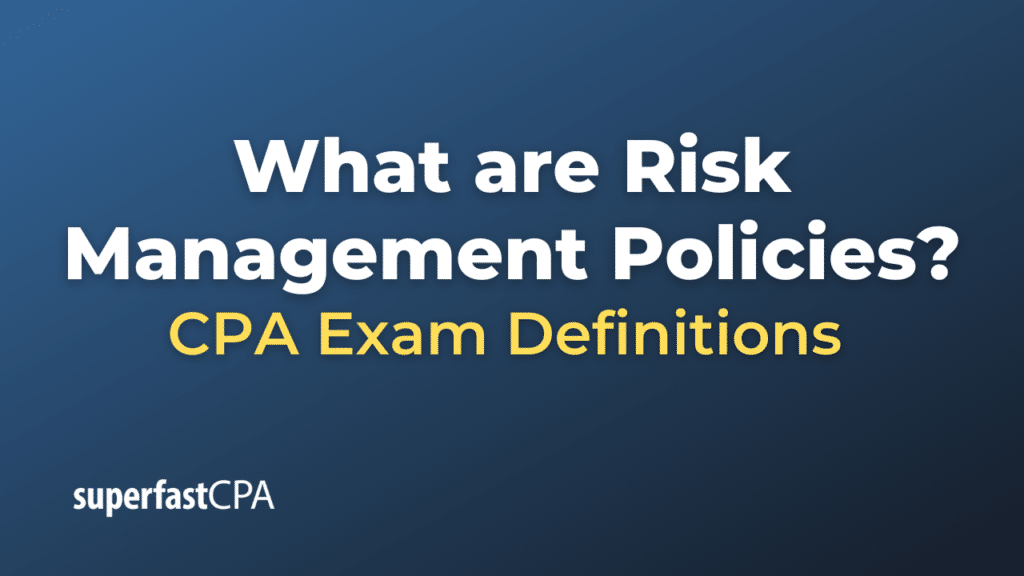Risk Management Policies
Risk management policies are formalized guidelines or sets of rules established by an organization to identify, assess, manage, and monitor risks. These policies provide a framework for ensuring that risk management practices are consistently applied throughout the organization, thereby aligning with its overall objectives and strategy.
Key components and characteristics of risk management policies include:
- Purpose and Scope: This section defines why the policy exists and the areas or activities it covers.
- Risk Appetite and Tolerance: This defines the level and types of risks the organization is willing to accept or avoid to achieve its objectives. For instance, a tech startup might have a high-risk appetite in pursuit of rapid growth, while a pension fund might have a low-risk appetite to prioritize the preservation of capital.
- Roles and Responsibilities: Clearly outlines who is responsible for what in the risk management process. This can range from board members, who are responsible for overseeing the risk management strategy, to specific risk management teams or individuals assigned to handle day-to-day risks.
- Risk Assessment Process: Describes the standardized procedure for identifying and evaluating risks. This might include steps like risk categorization, risk ranking, and the methods used to quantify risks.
- Risk Response Strategy: Defines the approach to address identified risks, whether it’s risk mitigation, transfer, acceptance, or avoidance.
- Reporting and Communication: Details how risks and risk management activities will be reported and communicated within the organization. This ensures transparency and keeps stakeholders informed.
- Monitoring and Review: Describes the frequency and methods for monitoring existing risks, reassessing the effectiveness of current risk management strategies, and identifying new risks.
- Training and Resources: Emphasizes the need for ongoing training in risk management and ensures that necessary resources, such as software or external consultants, are available.
- Feedback and Continuous Improvement: Encourages feedback from different levels of the organization to refine and enhance the risk management process continually.
- Policy Review and Updates: Given that the business environment is dynamic and risks evolve, this section might define how often the risk management policy will be reviewed and updated.
Implementing and adhering to risk management policies offer several benefits:
- Consistency: Provides a consistent approach to risk management across the organization, ensuring that risks are handled in a uniform manner.
- Clarity: Establishes clear guidelines, roles, and responsibilities, which helps in streamlining decision-making and action plans related to risks.
- Compliance: Ensures the organization meets regulatory or industry-specific requirements related to risk management.
- Stakeholder Confidence: Boosts confidence among stakeholders, including investors, employees, and customers, by demonstrating a proactive approach to risks.
For risk management policies to be effective, they should be well-communicated across the organization, supported by top management, and periodically reviewed and revised to ensure they remain relevant and effective in the current environment.
Example of Risk Management Policies
Let’s consider a hypothetical example of a risk management policy for a bank:
Risk Management Policy for XYZ Bank
1. Purpose and Scope: This policy outlines the risk management framework for XYZ Bank. It applies to all divisions and employees of the bank and covers credit risk, market risk, operational risk, and liquidity risk.
2. Risk Appetite and Tolerance: XYZ Bank adopts a conservative risk posture, prioritizing the safety of depositor funds and the bank’s reputation. Our risk tolerance levels are defined by a maximum potential loss of 5% of our equity for any single event or risk type.
3. Roles and Responsibilities:
- Board of Directors: Oversee the bank’s overall risk strategy.
- Chief Risk Officer (CRO) : Manage and implement the risk management framework, reporting directly to the board.
- Risk Management Team: Identify, assess, and monitor risks in their respective divisions.
- All Employees: Report any perceived risks or irregularities to their immediate supervisors or the risk management team.
4. Risk Assessment Process: Risks are categorized into ‘High’, ‘Medium’, and ‘Low’ based on their potential impact and likelihood. Each division undergoes a quarterly risk assessment, where potential risks are identified, assessed, and documented.
5. Risk Response Strategy:
- Credit Risk: Maintain diversified loan portfolios, conduct thorough credit checks, and set limits on loan exposures.
- Market Risk: Engage in hedging strategies and limit exposure to volatile markets.
- Operational Risk: Regularly review and update internal processes, conduct employee training, and invest in reliable technology.
- Liquidity Risk: Maintain a diversified portfolio of liquid assets and monitor cash flows daily.
6. Reporting and Communication: The CRO will provide a comprehensive risk report to the board semi-annually. Each division head must submit quarterly risk reports to the CRO. Significant risks or incidents must be reported immediately.
7. Monitoring and Review: The risk management team will continuously monitor and review the risk environment. An external audit of the risk management process will be conducted annually.
8. Training and Resources: All employees will undergo risk management training annually. The bank will also allocate funds for risk management software and tools as required.
9. Feedback and Continuous Improvement: Employees are encouraged to provide feedback on the risk management process. A feedback box will be placed on the bank’s internal portal. The risk management team will review this feedback quarterly.
10. Policy Review and Updates: This policy will be reviewed and updated annually by the CRO in consultation with the board and other relevant stakeholders.
This is a simplified example, and in reality, the policy of a bank would be much more detailed, taking into account the specific complexities of banking operations and the various regulations that banks must adhere to. However, this example gives a basic idea of how a risk management policy might be structured.













